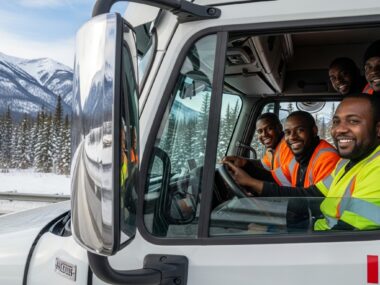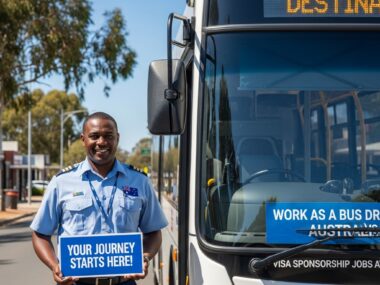Canada’s fuel stations are buzzing with opportunity, offering you a chance to work in a lively environment, connect with people, and build a future in a country known for its stunning landscapes and welcoming communities. Fuel station attendant jobs in Canada are in high demand, providing stable employment and visa sponsorship opportunities for international workers looking to secure a Canada work visa. With the country’s vast road networks and growing need for transportation services, these roles are popping up everywhere, from vibrant cities like Toronto to small towns in Alberta. In this guide, we’ll walk you through everything you need to know about landing fuel station attendant jobs in Canada with visa sponsorship, including the day-to-day tasks, benefits, challenges, and steps to make your Canadian dream come true. Let’s get rolling!
What Does a Fuel Station Attendant Do in Canada?
Working as a fuel station attendant in Canada is all about keeping the station running smoothly while putting smiles on customers’ faces. Most stations are self-serve, so you won’t be pumping gas often, but you’ll handle tasks like processing payments, stocking the convenience store, and keeping the pumps and forecourt clean. You might sell snacks, drinks, or car accessories, manage cash or card transactions, and sometimes help with small vehicle checks like tire pressure or windshield fluid top-ups. It’s a dynamic job that blends customer service with hands-on work, ideal for those who like staying active and engaging with people.
These roles are classified under the National Occupational Classification (NOC) code 65100, labelled as “service station attendants.” This code is crucial when applying for fuel station attendant jobs in Canada with visa sponsorship, as it aligns your skills with immigration requirements. The demand is strong – Canada’s reliance on vehicles and its extensive highways mean fuel stations are vital. You’ll find openings at major chains like Petrol-Canada, Shell, or Esso, as well as local stations, especially in provinces like Ontario, British Columbia, and Alberta, where job postings are plentiful.
On a personal level, you’ll meet a diverse crowd – truckers sharing road stories, families on vacation, or locals grabbing coffee. It’s rewarding but can be demanding, with long shifts and outdoor tasks in Canada’s cold winters. If you enjoy a role that keeps you moving and connected, this could be your perfect fit.
Why Choose Fuel Station Attendant Jobs in Canada?
Why pick Canada for fuel station work? Canada offers an incredible quality of life, with universal healthcare, safe communities, and a culture that embraces newcomers. Fuel station attendant jobs are entry-level, meaning you don’t need advanced education, and many come with visa sponsorship opportunities that can lead to permanent residency. The job market is thriving – Canada’s economy depends on transportation, making fuel stations essential, especially in urban centers and rural areas. Recent data shows thousands of openings, with Alberta and Ontario leading due to their oil and gas industries.
The pay is solid for an entry-level role. Fuel station attendants earn $16 to $20 per hour on average, equating to about $32,000 to $40,000 annually for full-time work. In pricey cities like Vancouver or Toronto, wages can hit $22 per hour, and some stations offer perks like free meals or fuel discounts. Rural roles might include housing support, cutting your costs. Canada’s immigration system is also a big draw, with programs like the Temporary Foreign Worker Program (TFWP) or Provincial Nominee Programs (PNPs) offering visa sponsorship for fuel station attendants, paving the way for long-term stays.
Beyond the pay check, it’s about lifestyle. On your days off, you could explore Banff’s mountains, Vancouver’s markets, or Montreal’s festivals. Canada values work-life balance, so flexible shifts are common, letting you enjoy your new home. For many, these jobs are a launchpad to bigger goals, like permanent residency or citizenship.
Eligibility Requirements for Fuel Station Attendant Jobs with Visa Sponsorship
Ready to get started? Here’s what you need to qualify for fuel station attendant jobs in Canada with visa sponsorship. The requirements are straightforward. A high school diploma or equivalent is usually enough – if it’s from outside Canada, you’ll need an Educational Credential Assessment (ECA) to confirm it meets Canadian standards. Experience isn’t always required, but six months in customer service or retail can make you stand out. Many employers offer on-the-job training, so enthusiasm and a willingness to learn go a long way.
Language skills are essential. You’ll need basic proficiency in English or French, typically proven with a test like IELTS or CELPIP, aiming for a Canadian Language Benchmark (CLB) of 4 or higher. This ensures you can handle customer interactions and workplace instructions. You’ll also need to pass health and character checks, including a medical exam and police certificates, to show you’re fit and trustworthy. If applying from outside Canada, you’ll need settlement funds – around CAD $13,000 for a single person – to prove you can support yourself initially.
A job offer is the key to visa sponsorship. Employers must often provide a Labour Market Impact Assessment (LMIA), proving no Canadian can fill the role, though some streams simplify this. The offer must be full-time and from a legitimate employer, like a fuel station or chain, not a recruitment agency. Provinces like Alberta or British Columbia may prioritize these roles due to local demand.
If you’re already in Canada on a work permit, transitioning to sponsored roles is easier, especially through programs targeting in-Canada workers. Quebec has its own rules, so most opportunities focus on other provinces.
Exploring Visa Sponsorship Opportunities and Pathways
Visa sponsorship opportunities for fuel station attendants in Canada are accessible through several immigration programs. The Temporary Foreign Worker Program (TFWP) is a popular route, where employers secure an LMIA to hire you on a temporary work permit. This permit lets you work while gaining experience, often a stepping stone to permanent residency through programs like the Canadian Experience Class (CEC) or Provincial Nominee Programs (PNPs).
PNPs are a big deal for fuel station attendants. Provinces like Alberta, Saskatchewan, and British Columbia have streams targeting in-demand occupations, including NOC 65100 roles. For example, Saskatchewan’s Hard-to-Fill Skills Pilot includes fuel station jobs, offering sponsorship and a path to permanent residency. These programs often have fewer requirements than federal streams, making them ideal for entry-level workers.
Another option is the Atlantic Immigration Program (AIP) for Atlantic provinces like Nova Scotia or New Brunswick, where fuel station jobs are in demand due to rural needs. The AIP fast-tracks permanent residency for workers with job offers, and many employers in these regions offer sponsorship.
For temporary permits, processing times range from 2-6 months, depending on the stream and your country of origin. Permanent residency applications, like those through PNPs, can take 6-12 months. The beauty? Many programs allow family inclusion – your spouse can get an open work permit, and kids can study in Canada’s top-notch schools.
Step-by-Step Guide to Applying for Fuel Station Attendant Jobs and Visas
Let’s break down the process like we’re chatting over coffee. Step one: Build a resume highlighting any customer service or retail experience. Use job boards like Indeed, Workopolis, or Job Bank to search “fuel station attendant jobs in Canada with visa sponsorship” – thousands of listings pop up, from chains to local stations.
Step two: Land a job offer. Network on LinkedIn, join expat forums, or contact fuel station chains directly. Once you have an offer, gather your documents: proof of education, language test results, ECA (if needed), and medical/police checks.
Step three: Apply for the right visa. For a temporary work permit via TFWP, your employer submits the LMIA, then you apply through IRCC’s online portal. Fees are around CAD $155 for the permit, plus $100 for LMIA processing. For PNPs, apply through the province’s portal, with fees around CAD $500-$1,500, depending on the program.
Step four: If approved, arrive in Canada and start working. After gaining experience (usually one year), apply for permanent residency through CEC or a PNP. Stay patient – IRCC aims for efficiency, but backlogs can slow things down.
Pro tip: Use a licensed immigration consultant to avoid mistakes, and steer clear of shady recruiters promising guaranteed jobs for high fees.
Salaries, Benefits, and Lifestyle as a Fuel Station Attendant in Canada
Let’s talk money. Fuel station attendants earn $16 to $20 per hour on average, or about $32,000 to $40,000 yearly for full-time work. In cities like Toronto or Vancouver, wages can hit $22 per hour, and rural stations might offer housing or fuel discounts, boosting your effective income. Entry-level roles start around $15.50, but with experience, you can climb higher.
Benefits are a plus. Many stations provide health coverage, paid sick days, and contributions to the Canada Pension Plan. Some offer perks like free snacks or discounted gas, which add up. Shifts vary, with evening or weekend work common, but flexibility lets you balance life outside work.
Lifestyle? Canada’s a playground. Imagine weekends skiing in Whistler, strolling Ottawa’s markets, or catching a hockey game. As an immigrant, you’ll find vibrant communities – think Filipino or South Asian groups – to help you settle. Burnout is a risk with long hours, so prioritize self-care to stay energized.
More Visa Sponsorship Jobs in Canada Fruit Picker Jobs in USA 2025 with Visa Sponsorship
Challenges and How to Overcome Them
No job is perfect. Fuel station work can mean long hours, especially in bad weather, and dealing with the occasional grumpy customer. Immigration hurdles, like LMIA delays or application glitches, can frustrate. Rural roles might feel isolating, and adjusting to Canada’s culture or climate takes time.
To tackle these, research thoroughly – check IRCC updates and join online groups like Canada Visa forums for tips. Learn your rights under Canadian labour laws to avoid exploitation, as some recruiters charge illegal fees. Build a support network early, whether through co workers or community groups, to ease the transition. Challenges build resilience, and many attendants move into supervisory roles or other fields later.
Tips for Success in Landing Fuel Station Attendant Jobs with Visa Sponsorship
Want to shine? Tailor your resume to highlight customer service skills and reliability. Learn basic French for bilingual areas like New Brunswick. Volunteer or take short retail courses to boost your experience if needed.
Stay updated on immigration changes – programs like PNPs evolve fast. Budget for application costs, but check if employers cover LMIA fees. Above all, stay positive – a can-do attitude attracts employers and opens doors.
Wrapping Up: Your Path to a Rewarding Career in Canada
Fuel station attendant jobs in Canada with visa sponsorship offer more than a paycheck – they’re a gateway to a new life in a vibrant country. With high demand, accessible immigration pathways, and a chance to grow, these roles are perfect for hardworking folks ready for adventure. Sure, there are challenges, but the rewards – from stable income to exploring Canada’s beauty – are worth it. Start preparing today, and you could soon be fuelling your Canadian dream.
For more info, check these clickable links:
- Official IRCC Temporary Foreign Worker Program
- Job Search on Indeed for Fuel Station Jobs
- Canada Visa Application Guide






